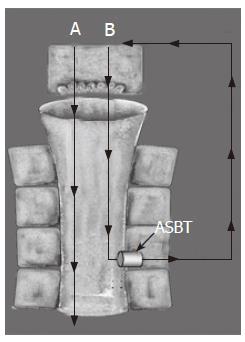Copyright
©2006 Baishideng Publishing Group Co.
World J Gastroenterol. Jun 14, 2006; 12(22): 3553-3563
Published online Jun 14, 2006. doi: 10.3748/wjg.v12.i22.3553
Published online Jun 14, 2006. doi: 10.3748/wjg.v12.i22.3553
Figure 1 Classic cholehepatic shunt pathway (B) compared to direct biliary bile acid secretion (A).
Bile acids that are poor substrates for coenzyme A (CoA) synthetase and inefficiently conjugated by hepatocytes are passively absorbed by biliary epithelium. After canalicular secretion, the unconjugated bile acid is absorbed by cholangiocytes because of the high lipophilicity of the protonated acid. The absorbed bile acid is returned to the hepatocyte mass via the periductular plexus. The osmotic effect of multiple passages of the unconjugated bile acid anions into canalicular bile results in hypercholeresis. The presence of ASBT on the apical membrane of cholangiocytes provides a potential mechanism for absorption of conjugated bile acids that then follows the same shunt pathway as described above.
- Citation: Xia X, Francis H, Glaser S, Alpini G, LeSage G. Bile acid interactions with cholangiocytes. World J Gastroenterol 2006; 12(22): 3553-3563
- URL: https://www.wjgnet.com/1007-9327/full/v12/i22/3553.htm
- DOI: https://dx.doi.org/10.3748/wjg.v12.i22.3553









